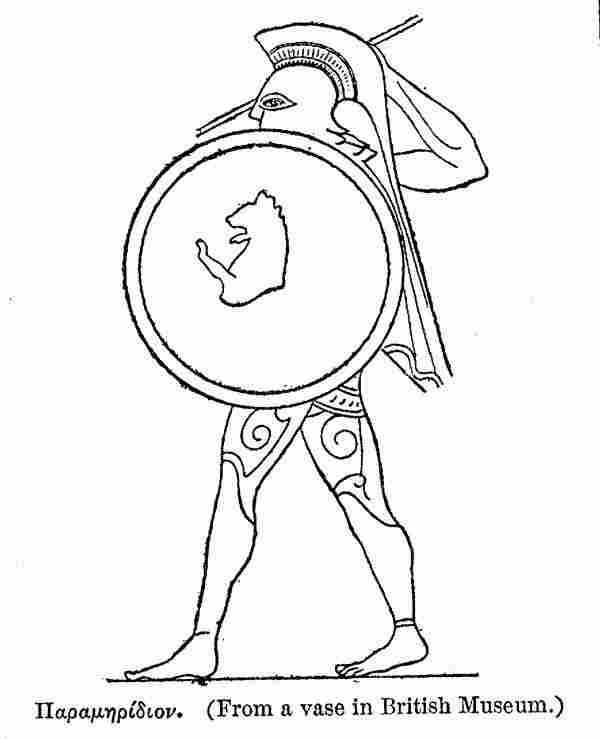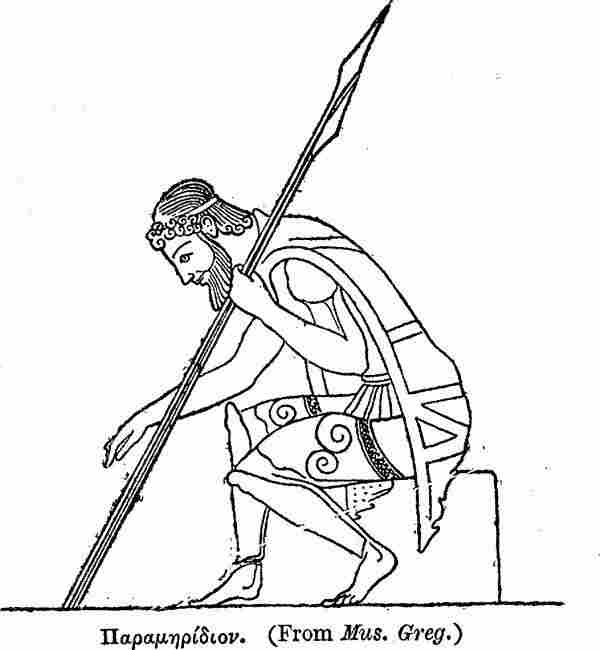.
PERIMERI´DIA or PARAMERI´DIA (περιμηρίδια, Arrian. Tact. 4; παραμηρίδια more usually), armour for the thighs, cuisses. These articles of armour, though not in common use in the ordinary Greek panoply, are shown sufficiently often on the monuments as occasionally employed by Greek warriors at least as far back as the fifth century B.C. The accompanying illustrations show what may be

Παραμηρίδιον. (From a vase in British Museum.)
gathered as to their general form. They seem to have been adapted to the shape of the thigh, clasping it round in the same way as the greave clasped the leg. The lower edge is in some cases curved out in such a way as to allow room for that part of the greave which protected the knee (see fig. 1). Like the greave, too, the parameridia seem to have been constructed of metal, as is probable both from the character of the decorations traced upon them in the vase pictures, and also from the fact that they are usually there coloured like the greave. [n the British Museum is a bronze object which from its form would be adapted to the parameridion, and may have been actually intended for this purpose.
For instances of its occurrence in vase-paintings, see Brit. Mus. Cat. of Vases, Nos. 473, 557, 591, 608; vase in Brit. Mus. B 50; Gerhard, Aus. Vas. ii. pl. cxxii.; Mon. Ined. 6.78; and Mus. Greg. ii. liii.

Παραμηρίδιον. (From
Mus. Greg.
)
All these instances occur upon black-figured vases; at present no illustration of these weapons is known in art later than the fifth century B.C. In Greek writers, however, of the third century B.C. and downwards, they are frequently mentioned, but here almost exclusively as employed by cavalry, both for the rider and his horse. Xenophon (Xen. Anab. 1.8, 6) describes the armour of the 600 horsemen with Cyrus as consisting of thorax, parameridia, and helmet. The same writer (de Re Eq. 12, 8 and 10) speaks of them as among the necessary equipment of a cavalry soldier: cf. especially Id. Cyr. Inst. 7.1, 2, where they are described as of bronze, alike for horses and riders; and Arrian, Tact. 4, where the riders have περιμηρίδια, the horses παραπλευρίδια. For parameridia as part of the protective armour of the horse in action, see also Xen. de Re Eq. 12, 8, and Pollux, 1.140. Xenophon (Cyr. Inst. 6.4) makes a further distinction of παραπλευρίδια for horses driven in chariots and παραμηρίδια for those ridden by the cavalry.
Dictionary of Greek and Roman Antiquities
| Ancient Greece
Science, Technology , Medicine , Warfare, , Biographies , Life , Cities/Places/Maps , Arts , Literature , Philosophy ,Olympics, Mythology , History , Images Medieval Greece / Byzantine Empire Science, Technology, Arts, , Warfare , Literature, Biographies, Icons, History Modern Greece Cities, Islands, Regions, Fauna/Flora ,Biographies , History , Warfare, Science/Technology, Literature, Music , Arts , Film/Actors , Sport , Fashion --- |


